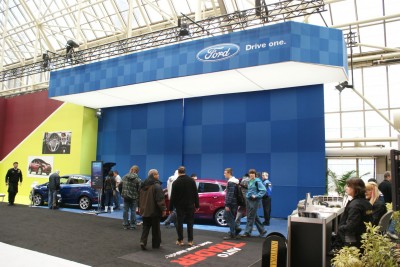 Drivers of growth
Drivers of growth
Trade show exhibitors were keen on fabric-based soft signage for a variety of reasons. Initially, it helped their branded graphics stand out from the crowd. Another benefit, however, was the low weight of the material compared to rigid substrates.
“Reducing the weight of trade show display components is actually a big deal in terms of reducing the costs of transportation,” Murray says. “You can just roll up the graphics and go. That small, light, portable side of the business has seen exponential growth.”
The overall trade show business has seen a downward trend, however, with fewer big events in recent years. Among McRae’s customer base, this difference has been more pronounced in the U.S. than in Canada.
“The U.S. used to represent 30 to 40 per cent of our business, but now it’s closer to 25 per cent,” Murray says. “Some of the economic growth in Canada has made up for that. We’re also fortunate that we don’t specifically serve the event industry itself, but instead work with people who decide upon the graphic applications. So, we custom-integrate fabrics and aluminum structures into very big displays for annual meetings and other events that have taken budgets away from trade shows. We’ve created backdrops for baseball games, for example, and massive outdoor tents with dye-sublimated graphics. Our business is changing every day.”
McRae has also targeted point-of-purchase (POP) applications in retail stores, where there seems to be greater potential for growth.
“In the past two years, we’ve had some of our trade show projects transfer into retail projects,” he says. “We produced more than 600 fabric ‘halos’ for Circuit City, for example, to help identify the different product areas within a store; but we only got 100 or so installed before they went out of business! And there have been other, smaller opportunities.”
He also says pursuing this market will require a long-term view.
“Most POP graphics here in Canada are still PVC, which is cheaper,” says Murray, “whereas in certain markets in Europe, they’re way ahead in using fabrics instead.”
 Further integration
Further integration
McRae now comprises a staff of 40 in a 2,323-m2 (25,000-sf) facility. In addition to dye-sub printing on 13 presses, in-house capabilities include design services, structural fabrication, finishing and system integration.
“We haven’t grown every single year,” says Murray, “but this past year we have seen an increase of almost 50 per cent. The pattern depends partly on the market and partly on our changing capabilities. We manage cost containment well, we maintain our operations efficiently and our selling prices have always gone down so far.”
Having successfully established itself in a narrow field, the company recently joined the Specialty Graphic Imaging Association (SGIA) and acquired new systems to better integrate itself into the broader printing industry.
“There are still lots of issues specific to our work, but the machines are getting faster, achieving better quality and supporting greater substrate widths,” Murray says. “We’re constantly watching progress in research and development (R&D), including not only new printers, but also printhead technology, inks, fabrics and transfer papers.”
For more information, visit www.mcrae-imaging.com.





